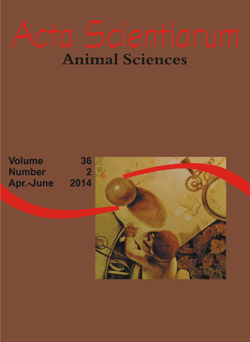<b>Light relations and performance of signal grass in silvopastoral system
Abstract
The aim was to evaluate the influence of different spatial arrangements of trees [(3×2)×20 m, (2×2)×9 m and 2×9 m] and sampling sites (center of row spacing and side of tree rows) with regard to the amount and quality of light in the understory of silvopastoral systems and their effects on the production and chemical composition of pasture. The experimental design was a randomized block in a split plot, with three replications. The sampling site affected absolute irradiance, photosynthetic active radiation (PAR), light interception (LI) and red/far red ratio, with higher rates in the center of spacing. There were high and positive correlations between LI/leaf area index (LAI), LI/dry mater (DM) and LAI/DM in the center and LI/LAI and FAR/DM in the side of tree rows. Spatial arrangement (3×2)×20 m had higher rates for plant height (PH), DM and neutral detergent fiber rate, while (2×2)×9 m had high leaf/stem ratio and crude protein rate. In the case of the sampling site, higher rates of PH and DM were reported in the center. Forage composition was not affected by sampling sites. Highest production of DM was obtained in the (3×2)×20 m arrangement and improvements in forage composition were observed in denser arrangements.
Downloads
DECLARATION OF ORIGINALITY AND COPYRIGHTS
- I Declare that current article is original and has not been submitted for publication, in part or in whole, to any other national or international journal.
The copyrights belong exclusively to the authors. Published content is licensed under Creative Commons Attribution 4.0 (CC BY 4.0) guidelines, which allows sharing (copy and distribution of the material in any medium or format) and adaptation (remix, transform, and build upon the material) for any purpose, even commercially, under the terms of attribution.
Read this link for further information on how to use CC BY 4.0 properly.








































